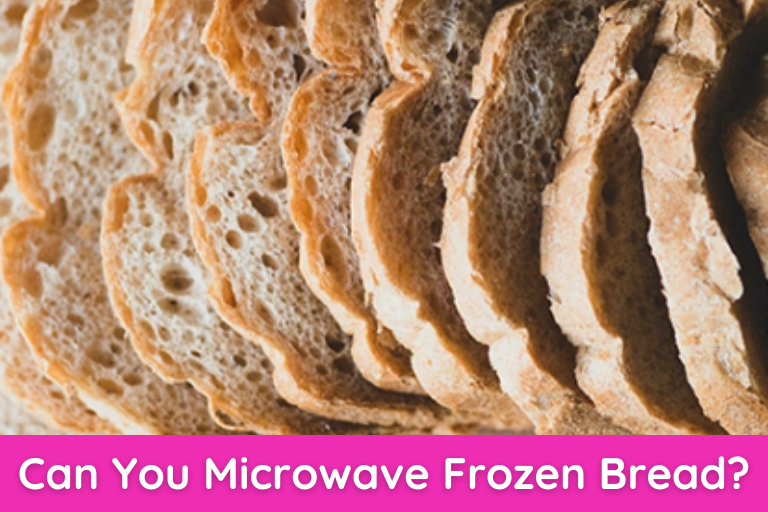Are you wondering whether it’s safe to pop frozen bread in the microwave? There’s no need to worry!
While it may take some experimentation, you can easily enjoy warm, toasty slices of your favorite frozen bread with just a few simple steps.
So, let’s start learning how to microwave frozen bread – it’s easier than you think!
Can You Microwave Frozen Bread?
Absolutely! While it may take some experimentation, you can easily enjoy warm, toasty slices of your favorite frozen bread with just a few simple steps. So let’s start learning how to microwave frozen bread – it’s easier than you think!
Can I heat frozen bread in the microwave?
Yes, you can! You can heat frozen bread in the microwave, but it may take some experimentation to get the desired result. The key is to remember not to overcook the bread, so it doesn’t become hard or chewy.
To achieve this, check on your bread every 30 seconds and adjust the time accordingly. With a little practice, you’ll enjoy warm, delicious slices of frozen bread in no time!
Why should you not put bread in the microwave?
It would help if you didn’t put bread in the microwave unless you are trying to heat it. If you put bread in the microwave without heating it, it can become excessively dry and brittle, compromising its flavor and texture.
The best way to keep bread fresh is to store it in an airtight container at room temperature and enjoy it within a day or two.
Can you eat frozen bread without defrosting it?
Yes, you can eat frozen bread without defrosting it. However, for optimal taste and texture, it is best to thaw the bread or heat it before consuming it. To thaw frozen bread, leave it on the counter for a few hours and let it come to room temperature.
To heat frozen bread in the oven or microwave, read the instructions on the packaging for the best results.
Why does frozen bread go hard in the microwave?
Frozen bread can go hard in the microwave because of the prolonged cooking time required to defrost it. Because microwaves heat from the inside out, frozen bread may cook on the outside before it is thawed in the center.
This can result in a hard and chewy texture. It is best to defrost frozen bread slowly by leaving it at room temperature or heating it for a shorter time in an oven or toaster.
How do you refresh frozen bread?
Refreshing frozen bread is easy and can be done with a conventional oven or toaster. To refresh a frozen loaf of bread in the oven, set your oven to 350°F and place the loaf in the middle rack.
Cook for 10-20 minutes until the outside of your bread has thawed and the inside is soft and warm. For rolls or smaller slices of frozen bread, use a toaster. Toast them for 8-10 minutes until they have reached desired crispness.
Does microwaving bread make it chewy?
Microwaving bread can make it chewy, especially if frozen or heated for too long. It is important to defrost frozen bread slowly, so it does not become hard or rubbery.
Heating times should also be kept short to avoid overcooking and a chewy texture.
Why do people put bread in the microwave?
People put bread in the microwave because it is a fast and convenient way to heat it quickly. This is especially useful for frozen bread, as the microwave can defrost it more quickly than a conventional oven.
It can also warm up already-cooked bread and make it crispier. However, microwaving should be done with caution, as it can cause chewy or rubbery textures if done for too long.
Can bread be refreshed in the microwave?
Yes, bread can be refreshed in a microwave. To do this, dampen a paper towel or kitchen cloth with water and wrap it around the bread.
Then place it in the microwave for no longer than 10 seconds. This should give your bread a fresh, crisp texture without making it chewy.
How do you microwave frozen bread without it getting soggy?
To microwave frozen bread without it getting soggy, you should cook it on a lower setting for a shorter time. This will help to prevent the bread from overcooking and becoming too soft.
Additionally, you can place a paper towel or kitchen cloth over the bread to help absorb any excess moisture.
How do you defrost bread quickly without a microwave?
To defrost bread quickly without a microwave, the best method is to remove it from its packaging and place it in a preheated oven.
Set the temperature between 300 and 350 degrees Fahrenheit, and cook for 10 minutes (or until the desired consistency is achieved).
Can you reheat frozen bread?
Yes, you can reheat frozen bread. The best way to do this is by taking the bread out of its packaging and then wrapping it in a damp paper towel or kitchen cloth.
Place it on top of a warm object, such as an oven door or heating pad, until the desired temperature is reached.
Alternatively, you can place the frozen bread in a preheated oven at 350 degrees Fahrenheit for 7-10 minutes.
How do you reheat frozen bread without an oven?
One way to reheat frozen bread without an oven is by taking it out of its packaging and then wrapping it in a damp paper towel or kitchen cloth.
Place it on top of a warm object, such as an oven door or heating pad, until the desired temperature is reached.
Another method is placing the frozen bread in a skillet over low heat, flipping it occasionally until heated.
FAQ:
How long does it take to defrost bread?
It usually takes about 15 minutes to defrost bread. This can vary depending on the type and size of the bread. For example, a large or frozen loaf may take up to 20 minutes, while smaller pieces only need 10-15 minutes. To speed up the process, leave the bread in a microwave-safe container and microwave it on the defrost setting.
What to do with frozen bread?
Frozen bread can be used in a variety of ways. You can toast or bake it or use it as an ingredient in recipes such as pizzas, casseroles, soups, and stews. You can also break it into chunks and add them to salads for a crunchy texture. For sandwiches, you could defrost the frozen bread before toasting it for a delicious flavor.
How long does bread last in the microwave?
Bread can typically last up to three minutes in the microwave without getting burned or hard. However, keeping an eye on the bread while microwaving is important to ensure it doesn’t get too hot. If the bread starts to get dark spots or smell like burning, it should be removed from the microwave immediately.
What is the best way to microwave bread?
The best way to microwave bread is by using the defrost setting. This will slowly heat the bread and prevent it from becoming dry or tough. When using the reheat setting, it’s important to watch closely and ensure that the bread does not burn.
How do you reheat frozen flatbread?
To reheat frozen flatbread, place it on a microwave-safe plate and heat it on the defrost setting for 30 seconds to 1 minute. Then, switch to the reheat setting and heat for 10-20 seconds or until the bread is warmed to your liking.
You can also reheat frozen flatbread in the oven by placing it on a baking sheet and heating it at 400 degrees Fahrenheit for 5-10 minutes.
How do you defrost a loaf of bread in the microwave?
To defrost a loaf of bread in the microwave, place the frozen loaf on a microwave-safe plate and set the power level to 50% for 1 minute. After one minute, flip the loaf over and set the power level to 30% for an additional 3 minutes. Once time is up, check to ensure the bread has thawed, and then adjust your cooking time as needed.
Should I put bread in the freezer or fridge?
Generally, it is best to store bread in the fridge. This will help keep it from becoming stale and prevent bacteria and mold from growing.
To preserve freshness for longer periods, wrap the bread tightly in aluminum foil or place it in an airtight container before putting it in the refrigerator.
You can also freeze bread for up to 3 months by wrapping it tightly in plastic wrap or aluminum foil and squeezing the air before sealing.
What are the benefits of freezing bread?
Freezing bread has several benefits. By freezing your bread, you can dramatically extend its shelf life, allowing you to keep it fresh for weeks or even months.
This is especially useful if you don’t use all of the bread you purchased in one day, as freezing it will help prevent any food waste.
Is frozen bread healthier than fresh?
There is no significant difference in health benefits between fresh and frozen bread. However, freezing and thawing can affect the texture of the bread, making it chewier or drier.
Is toasting frozen bread good for you?
Toasting frozen bread can be a healthy and delicious way to enjoy it. Toasting the bread will help make it crispier while adding flavor to it. The toasting process also helps reduce the amount of moisture in the bread, which can help prevent mold growth or spoilage.
Does warming up bread soften it?
Yes, warming up bread can soften it. When the temperature of the bread rises, it causes the proteins and starches in the dough to break down. This process makes the bread softer and more pliable as it breaks apart.
How do you defrost and cook bread?
There are a few different ways to defrost and cook bread. One way is to place the frozen bread on a baking sheet and bake it at a low temperature until it is thawed and cooked through.
Conclusion
From defrosting and reheating with the microwave to baking in the oven, there are plenty of ways to cook frozen bread. Each method can yield different results depending on your desired texture and flavor.
Whether you’re looking for a crispy crust or a soft interior, it’s important to consider what type of bread you have before deciding which cooking technique will work best for you.
Have you ever tried microwaving frozen bread? What was your experience like? Let us know in the comments below!




